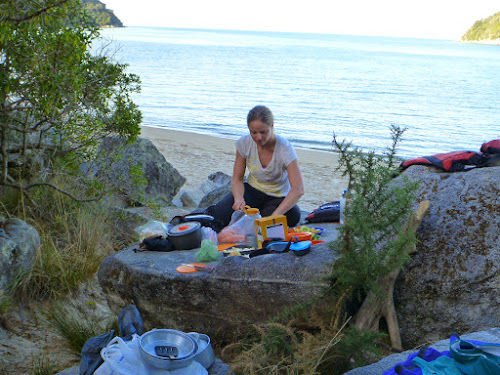Our first overnight backpacking trip into the New Zealand countryside was to the Mt. Owen massif - this impressive area of limestone carved cliffs and large alpine bowls was used as the filming location for the Gates of Moria in the Lord of the Rings movie trilogy.
The amazing part of this climb was that it allowed us to see so many different types of forest. Starting in the lowlands we were in a tropical and lush river valley, interspersed with cattle and alpaca farms. After climbing for a few hundred meters we quickly left the grasslands of the farming paddocks behind and entered into old growth beech forest. Covered in black moss, these beech trees provided an ample supply of sweet honey dew to feed the raging wasp population.
There were such a large number of wasps in the forest that there was a constant buzz in the background - luckily, for the most part, the wasps did not bother us and minded their own business (until I had a run in with a particularly surly wasp who decided that my shin was in its way).
One of the most amazing parts of this forest was the number of songbirds - we were continually surrounded by fantails, and bell birds singing as we climbed. It's hard to describe what they sounded like, but the best analogy I could come up with was the "pew pew" of a sci-fi laser beam...

After about 1000m vertical of climbing we reached the valley containing the Granby hut. This backcountry hut was absolutely amazing by Canadian standards. Being in such a remote location I was expecting a tin can with a bunk or two, but instead we arrive at a backcountry palace. Building this hut must have been a serious undertaking - completely insulated with indoor and outdoor stainless steel cooking areas, a large covered patio, rainwater harvesting system with 4000L of storage capacity, and all double glazed windows. Wow. This hut had some serious thought and engineering put into it with all supplies flown in by helicoptor. The most amazing thing about this hut is that is it only one of over 900 managed by the New Zealand department of conservation (DOC)! Pretty much every tramp (=hike in New Zealander) here has some sort of hut for shelter - glad I didn't bring a tent! Being a weekday we even had the whole place to ourselves.

The next day we woke to a beautiful New Zealand bluebird stunner and set out for the summit of Mt. Owen. Climbing an old glacial morain quickly brought us out of the scrub of the valley and into broad alpine grassland speckled by limestone and marble boulders.
Hiking up to the summit of Mt. Owen we had to pass through a maze of water carved limestone and marble that formed the most impressive structures. The best description we could come up with was that it looked like a tumbling glacier ice-fall, but made of rock - smooth surface from glacial erosion but containing large jagged rock crevasses. It definitely made for some exciting tramping!
To reach the final summit we had to battle with Smaug, the dragon of Mt. Owen - luckily, Marie's super powers prevailed and we were able to enjoy a great view of all the surrounding mountains and city of Nelson in the far distance.
I can definately understand why the LOTR movies chose this area for filming - absolutely stunning. We will definitely have to tick off a few more of these filming locations before we leave NZ
Click here for more photos!






























